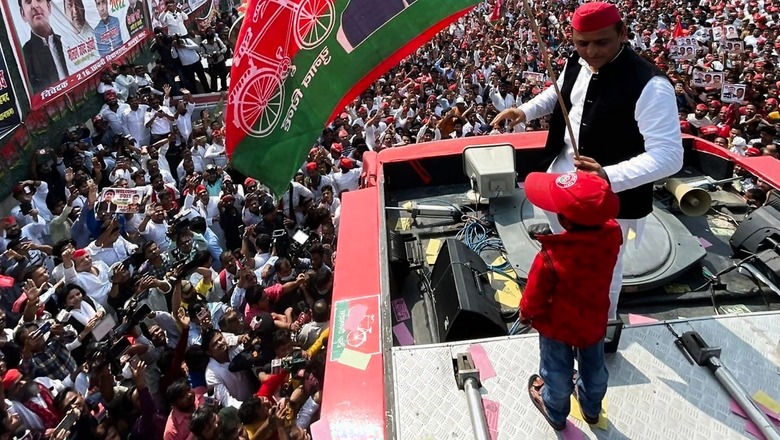
views
This time, in the political arena of Uttar Pradesh, Akhilesh Yadav-led Samajwadi Party is being pitted against the mighty BJP. The saffron party has not only changed the game in the state since 2013, but left an indelible mark in national politics.
With its realignment strategy, the BJP finally got its caste arithmetic right over two decades of hard labour. But has the SP, the BJP’s main rival in UP, changed its tact for the 2022 assembly elections? The party’s usual Yadav-Muslim formula seems to have an additional Hindu factor in it.
BJP’s story of loss
After 2002, the BJP, which was the political force behind Ram Janmabhoomi Movement in Uttar Pradesh in the 1990s, saw its support base shrinking considerably. The party that got a clear majority in 1991 under Kalyan Singh, was battered election after election, with regional satraps, Mulayam Singh Yadav of the Samajwadi Party Mayawati of the Bahujan Samaj Party, taking centre stage.
In 2007, in fact, the BSP got complete majority with Mayawati becoming the first chief minister to complete a five-year term in the state. In 2012, her government was replaced by the SP’s complete-majority mandate with Akhilesh Yadav becoming the second CM to complete a five-year term.
The BJP was a distant third in both elections. Clearly, the saffron party could not retain its support base among traditional voters, such as upper castes and banias, and lost votes from other supporting communities as well.
It seems, the BJP had surrendered to the caste arithmetic of the SP and the BSP, which focused exclusively on Muslim votes. The campaign strategy of both parties was to target caste and community-based votes: Yadav-Muslim combine for the SP and Jatav-Muslim combine for the BSP, with Mayawati being from the Jatav community.
Together, Yadavs and Jatavs make up close to 10 to 11 per cent each of the total population of Uttar Pradesh, and can make a significant portion of the winning combination when combined with 19 per cent Muslim population. Both these parties needed additional votes from other caste groups, and Mayawati focused on Brahmins and other Dalits while Mulayam and, later Akhilesh, went for other backward and some upper caste votes. But the target exclusively was to appeal to Muslim vote bank because of its sheer numbers.
In the 2007 assembly election, the SP gave tickets to 58 Muslim candidates, while the BSP gave tickets to 61 and the Congress to 49. The BSP emerged the winner and formed the government. In the 2012 assembly election, the SP gave tickets to 78 Muslim candidates, the BSP to 85 and the Congress to 62.
This time, however, the SP formed the government after winning comfortable majority. A total of 68 Muslim candidates won, creating a record with the community’s representation in the state legislative assembly.
The realpolitik
But 2013 witnessed three developments that changed the face of politics not just in Uttar Pradesh but across India: communal riots in Muzaffarnagar in Uttar Pradesh.
In the riots between Hindus and Muslims, over 60 people were killed and more than 40,000 displaced. Its effects were felt across India.
The Akhilesh-led SP was blamed by opposition parties. But 2013 also saw Gujarat CM Narendra Modi becoming the BJP’s prime ministerial candidate, followed by his decision to contest from Varanasi Lok Sabha parliamentary seat.
Modi, if a Hindutva political leader, was also known for his pro-development governance and politics. He was seen as a good face to take on the UPA-led government that had, by then, earned an “anti-public notation” of “nine years-nine scams”.
The BJP was looking for caste realignment in Uttar Pradesh. It wanted to bring all non-Yadav OBCs and non-Jatav Dalits under its wing to shape its political campaign for the rest of India. The party said if you win Uttar Pradesh, it means you win India.
It was not just the 2013 riots, however, that pushed Hindu votes towards the BJP. It was a combination of all three factors that pushed 70 per cent of the electorate in UP towards the BJP.
The party was successful in its attempt to realign Hindu votes, while blaming SP and BSP for following “minority appeasement politics” — a realpolitik that SP, BSP or even other political parties could not read in the state, which reflected in their election management in the upcoming elections.
In the 2014 Lok Sabha elections, the SP fielded 13 Muslim candidates, the BSP 19 and the Congress nine. None could win. The BJP, with its allies, while winning 73 out of 80 Lok Sabha seats in UP, also won all 21 seats where Muslims were over 10 per cent of the population.
The BJP, rising on Hindu vote mobilisation, became the first government after 1984 to get complete majority in the Lok Sabha elections. In the 2017 assembly election, the SP-Congress alliance gave tickets to 87 Muslim candidates while the BSP gave tickets to 99.
The BJP still got an absolute majority and formed the government. In 140 assembly constituencies, with over 20 per cent Muslims in each, the BJP and its ally Apna Dal won 111 seats.
Two massive losses in the previous elections pushed for some course correction in the 2019 Lok Sabha polls, it looks but on the ground, nothing significant moved. The SP and the BSP fought that election in alliance and fielded just 10 Muslim candidates this time. Six won, three from each party. The Congress fielded eight Muslim candidates, but none could win. Overall, the BJP alliance won 64 seats with an increase in vote share, touching 50 per cent mark, while SP-BSP alliance won 15 seats. The Congress could win just one seat, while losing the family bastion of Amethi.
What’s in store for 2022?
Now, coming to the 2022 assembly elections — when the BSP is not being seen as a major political player this time and BJP and SP are being considered main rivals. The SP, seeing its past experience, is focusing more on appealing to Hindu voters this time. The party is looking to add more Hindu votes to the Yadav-Muslim combine.
The first two phases of the elections, covering 113 seats, will see 23 Muslim candidates contesting. In its official list of 257 constituencies, so far, there are just 45 Muslims. What is more significant is that the party is not fielding Muslim candidates even from districts such as Muzaffarnagar and Amroha, like it did in the past.
Akhilesh is also busy projecting an image pandering to Hindus, by calling himself Ram and Krishna bhakt, and has talked of establishing “Ram rajya”. He claims that Kashi Vishwanath Corridor was approved by his party and, if in power, he will complete the Ram Temple project in Ayodhya much earlier than the BJP.
The Samajwadi Party, however, is unusually silent on its Muslim candidates. Akhilesh is clearly a trying to create a new identity for his party.
But can it propel any good for the party on the ground? Only an election result can tell, but Akhilesh’s insistence on calling Muhammad Ali Jinnah India’s freedom fighter and putting him in the league of Mahatma Gandhi, Jawaharlal Nehru and Sardar Vallabhbai Patel will only sharpen his rivals’ campaign to portray him and his party as “anti-Hindu” and “anti-India”. When he says Pakistan is not the real enemy, he gives more fodder to the BJP to call him and his party “pro-Pakistan”.
And the “anti-Hindu” comments of the SP’s Muslim candidates will only add to this narrative – the party’s candidate from Meerut, Rafiq Ansari has said the BJP-led government has “tortured and suppressed” Muslims in the last five years and is engaged in spreading “Hindu gardi”. Combine this with the SP’s choice of candidates in Azam Khan and Nahid Hasan, who have allegedly made communal remarks in the past.
This is clearly another shot in the arm for the BJP’s campaign, which has many development projects lined up for the state. This comes with the possibility of Hindu vote mobilisation across its caste realignment base — with the beginning of Ram Temple construction in Ayodhya and grand opening of Kashi Vishwanath Corridor in Varanasi.
Read all the Latest Politics News here














Comments
0 comment